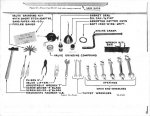It is really both ideas, I like to know what brand of tools were used during WWII that were supplied and also use them as required.
Currently, I'm posting on SmokStak, G503 and Steel Soldiers to get the most of the collective of ideas to fix, repair and yes get to a running condition.
This PE-197 died because owners really didn't keep them inside or out of the elements, the exhaust pipe was straight up and susceptable by the effects of rain water and rusting of the pipe and clogging the exhaust ports and like mine with the #3 bore filled up with the gunk, because the #3 exhaust valve was open.
The tools were recommended and near impossible to acquire. Thanks for the advice, this is what I need exactly, shared information. Thanks again, Mac
That clarification helps. I remain puzzled by the statement 'near impossible to acquire'. If you mean, for example, the exact oil can that some subcontractor produced for this unit in 1944, I would agree. But that is also the great so what. Any oil can will work. And if you search 'antique oil cans' on eBay you will find some that look pretty much like the one in the picture for less than $10.
I have wrenched flat motors for a good 40 years and I say again, there is not one special tool that is needed. Just regular tools anyone should have, a bit of resourcefulness and some creativity.
If you pull the head off and hit the #3 exhaust valve stem with a good penetrating oil and rotate the engine so that that cam lobe is down, you will be able to gently tap that valve closed. Repeat a few times. Lube the cylinders and you can even spin the motor over with the starter. That valve will free up and it will operate trouble-free afterwards.
Do an in-situ valve job by smearing some grinding compound on the seat of each valve and let the valve close. Rotate the valve back and forth 90 degrees. In the day there was a suction cup tool that looked like an eggbeater. Nowadays you can spin the valve with a screwdriver (if the face has a slot, some do) or a suction cup or even your own fingers (as the valve spring pressure is low). Clean with brake cleaner afterwards. Don;t leave any abrasive paste in the intake passage.
If the head is stubborn to remove after you undo the head bolts, use wooden wedges - the kind the hardware store sells for shimming door frames - staying clear of the valves.
If the studs holding the manifolds on to the block are rusty or broken, heat the stud a dull red and then touch candle wax to the threads. It will spin right out.
There are plenty of tricks and 1000 ways to skin a cat. Don't let concerns about having that exact setup deter you. Just dive in; you will be fine.



